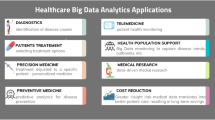Abstract
The healthcare domain in India is rapidly evolving with multiple healthcare and Hospital Management Information Systems (HMIS) being deployed at various medical facilities. However, aggregation and analytics on standardized healthcare datasets is possible only when these isolated systems are integrated on a common platform for exchange of patient Electronic Health Record (EHR) and data interoperability is facilitated. This presents a challenge due to the heterogeneous nature of systems and operational or policy-based restrictions in integrating them. In this paper, we present a distributed HMIS architecture which allows for integration of multiple stand-alone HMIS on a common platform that enables interoperability via EHR sharing and aggregation of standardized data for enabling analytics and visualization. Additionally, the proposed architecture also facilitates local, standalone deployments at primary medical facilities which are configured for local requirements and also synchronize essential datasets at the central node for enabling analytics. The deployment of this distributed architecture has also enabled uniformity and transparency in healthcare service delivery, while also facilitating better management and monitoring of available resources for efficient administration and governance.






Similar content being viewed by others
References
ANSI I (2003) Ts 18308 health informatics-requirements for an electronic health record architecture. ISO (Ed)
Bhatti R, Samuel A, Eltabakh M, Amjad H, Ghafoor A (2007) Engineering a policy-based system for federated healthcare databases. IEEE Trans Knowl Data Eng 19(9):1288–1304
Bui AA, Morioka C, Dionisio JDN, Johnson DB, Sinha U, Ardekani S, Taira RK, Aberle DR, El-Saden S, Kangarloo H (2007) Opensourcepacs: an extensible infrastructure for medical image management. IEEE Trans Inf Technol Biomed 11(1):94–109
Calamai R, Giarre L (2012) Enabling primary and specialist care interoperability through HL7 CDA release 2 and the chronic care model: an Italian case study. IEEE Trans Syst Man Cybern Part A Syst Hum 42(6):1364–1384
Dolin RH, Alschuler L, Boyer S, Beebe C, Behlen FM, Biron PV, Shabo A (2006) Hl7 clinical document architecture, release 2. J Am Med Inform Assoc 13(1):30–39
Donnelly K (2006) Snomed-ct: the advanced terminology and coding system for ehealth. Stud Health Technol Inform 121:279
DTS I (2001) 17090: Public key infrastructure
Furuie SS, Rebelo MS, Moreno RA, Santos M, Bertozzo N, Motta GH, Pires FA, Gutierrez MA (2007) Managing medical images and clinical information: Incor’s experience. IEEE Trans Inf Technol Biomed 11(1):17–24
ISO I (2009) Ts 22220: 2009 health informaticsidentif ication of subjects of health care. International Organisation for Standardisation
ISO I (2013) Health informatics—security and privacy requirements of EHR systems for use in conformity assessment
ISO I (2013) Health informatics—audit trails for electronic health records
ISO I (2014) Health informatics—personal health device communication—part 10418: device specialization—international normalized ratio (INR) monitor
ISO I (2015) ISO 13940: Health informatics—system of concepts to support continuity of care. International Organisation for Standardisation
ISO I (2016) Health informatics—information security management in health using ISO/IEC 27002
ISO 22600 B (2014) 22600-1: 2014, BS EN ISO 22600-1: 2014: health informatics. privilege management and access control. overview and policy management. Br. Stand. Institute
Kalra D, Lloyd D (2008) ISO 13606 electronic health record communication part 1: reference model. ISO 13606
Katehakis DG, Sfakianakis SG, Kavlentakis G, Anthoulakis DN, Tsiknakis M (2007) Delivering a lifelong integrated electronic health record based on a service oriented architecture. IEEE Trans Inf Technol Biomed 11(6):639–650
Mildenberger P, Eichelberg M, Martin E (2002) Introduction to the dicom standard. Eur Radiol 12(4):920–927
Ministry of Health and Family Welfare, Government of India: Electronic Health Record Standards for India (2016) https://mohfw.gov.in/sites/default/files/17739294021483341357.pdf. Accessed 30 Aug 2018
Namli T, Aluc G, Dogac A (2009) An interoperability test framework for HL7-based systems. IEEE Trans Inf Technol Biomed 13(3):389–399
Ranjan P, Soman S, Ateria AK, Srivastava PK (2018) Streamlining payment workflows using a patient wallet for hospital information systems. In: 2018 IEEE 31st international symposium on computer-based medical systems (CBMS). IEEE, pp 339–344
Rec I (2003) H. 264 & ISO/IEC 14496-10 AVC. Advanced video coding for generic audiovisual services
Soman S, Srivastava P, Murthy B (2015) Unique health identifier for India: an algorithm and feasibility analysis on patient data. In: 2015 17th international conference on e-health networking, application and services (HealthCom). IEEE, pp 250–255
Srivastava P, Soman S, Sharma P (2017) Perspectives on SNOMED CT implementation in Indian hospital management information systems. SNOMED CT Expo 2017(1):1–19
Srivastava S, Soman S, Rai A, Cheema A, Srivastava PK (2017) Continuity of care document for hospital management systems: an implementation perspective. In: Proceedings of the 10th international conference on theory and practice of electronic governance. ACM, pp 339–345
Sun J, Fang Y (2010) Cross-domain data sharing in distributed electronic health record systems. IEEE Trans Parallel Distrib Syst 21(6):754–764
Vasilescu E, Dorobanju M, Govoni S, Padh S, Mun SK (2008) WS/PIDS: standard interoperable PIDS in web services environments. IEEE Trans Inf Technol Biomed 12(1):94–99
Yuksel M, Dogac A (2011) Interoperability of medical device information and the clinical applications: an HL7 RMIM based on the ISO/IEEE 11073 DIM. IEEE Trans Inf Technol Biomed 15(4):557–566
Author information
Authors and Affiliations
Corresponding author
Rights and permissions
About this article
Cite this article
Soman, S., Ranjan, P. & Srivastava, P.K. A distributed architecture for hospital management systems with synchronized EHR. CSIT 8, 355–365 (2020). https://doi.org/10.1007/s40012-020-00301-8
Received:
Accepted:
Published:
Issue Date:
DOI: https://doi.org/10.1007/s40012-020-00301-8




